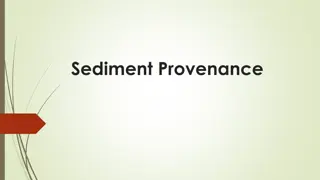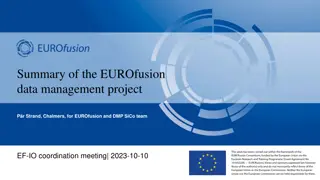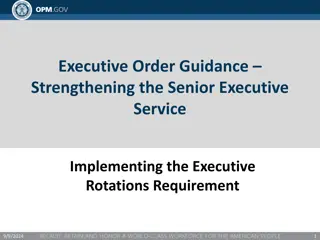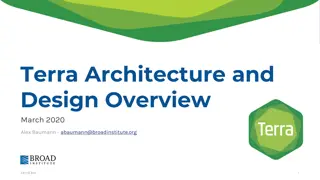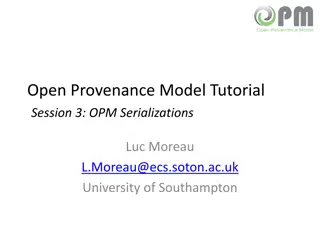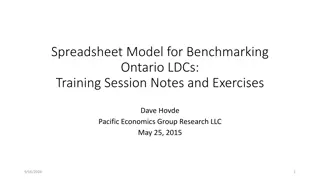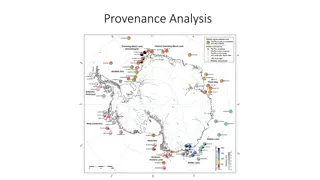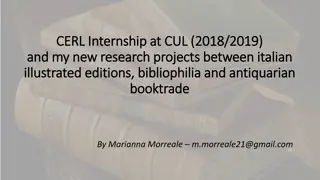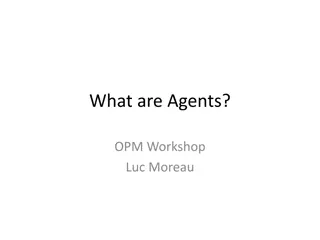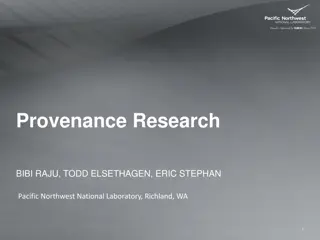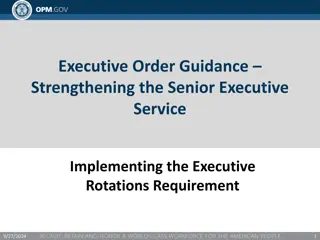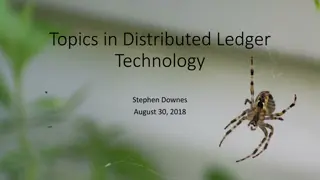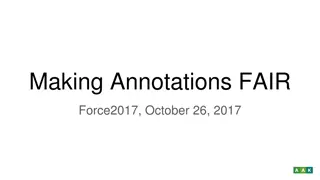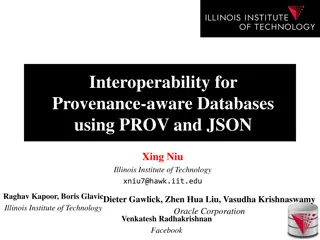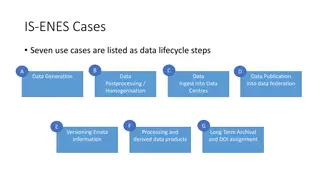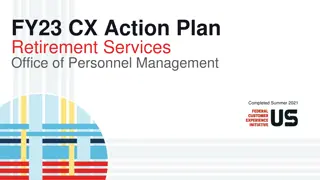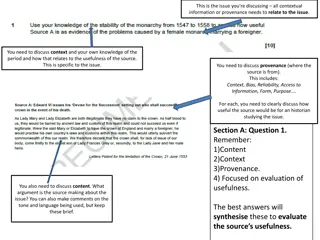Understanding Open Provenance Model (OPM) in Session 2
Dive into Session 2 of the Open Provenance Model tutorial to grasp the abstract model of OPM, its inferences, and efforts to imbue it with semantics. Explore OPM requirements, non-requirements, domain specialization, and its core layers. Discover how OPM allows for precise exchange of provenance information and the representation of causes in a detailed, technology-agnostic manner.
Download Presentation

Please find below an Image/Link to download the presentation.
The content on the website is provided AS IS for your information and personal use only. It may not be sold, licensed, or shared on other websites without obtaining consent from the author. Download presentation by click this link. If you encounter any issues during the download, it is possible that the publisher has removed the file from their server.
E N D
Presentation Transcript
Open Provenance Model Tutorial Session 2: OPM Overview and Semantics Luc Moreau L.Moreau@ecs.soton.ac.uk University of Southampton
Session 2: Aims In this session, you will learn about: The Open Provenance Model The definition of its abstract model The inferences it supports Various efforts to provide OPM with a semantics
Session 2: Contents Requirements and non-requirements Definition of OPM Specialization of OPM with Profiles Formalizations of OPM
OPM Requirements To allow provenance information to be exchanged between systems, by means of a compatibility layer based on a shared provenance model. To allow developers to build and share tools that operate on such provenance model. To define the model in a precise, technology- agnostic manner. To define bindings to XML/RDF separately To support a digital representation of provenance for any thing , whether produced by computer systems or not
OPM Non-Requirements OPM does not specify the internal representations that systems have to adopt to store and manipulate provenance internally. OPM does not specify protocols to store such provenance information in provenance repositories. OPM does not specify protocols to query provenance repositories.
OPM Layered Model OPM Domain Specialization: Workflow, Web Technology Bindings: XML, RDF OPM based APIs: record, query OPM Essential Profiles: Collections, Attribution OPM Core OPM Sig 7
Open Provenance Model Allow us to express all the causes of an item e.g., provenance of a bottle of wine includes: Grapes from which it is made Where those grapes grew Process in the wine s preparation How the wine was stored Between which parties the wine was transported, e.g. producer to distributer to retailer Where it was auctioned Allow for process-oriented and dataflow oriented views Based on a notion of annotated causality graph
Nodes Artifact: Immutable piece of state, which may have a physical embodiment in a physical object, or a digital representation in a computer system. Process: Action or series of actions performed on or caused by artifacts, and resulting in new artifacts. Agent: Contextual entity acting as a catalyst of a process, enabling, facilitating, controlling, affecting its execution. A P Ag
Edges A used(R) P wasTriggeredBy P1 P2 wasGeneratedBy(R) P A wasDerivedFrom A1 A2 wasControlledBy(R) Ag P Edge labels are in the past to express that these are used to describe past executions
Illustration Process used artifacts and generated artifact Edge roles indicate the function of the artifact with respect to the process (akin to function parameters) Edges and nodes can be typed A1 A2 used(dividend) used(divisor) P type=division Causation chain: P was caused by A1 and A2 A3 and A4 were caused by P Does it mean that A3 and A4 were caused by A1 and A2? wasGeneratedBy(quotient) wasGeneratedBy(rest) A3 A4
Hierarchical Descriptions (1) A1 A2 used(r1) used(r2) P wasGeneratedBy(r4) wasGeneratedBy(r3) A3 A4
Hierarchical Descriptions (2) A1 A2 used(r1) used(r2) Drill down P1 P2 wasGeneratedBy(r4) wasGeneratedBy(r3) A3 A4
Hierarchical Descriptions (3) A1 A1 A2 A2 used(r1) used(r2) used(r1) used(r2) P1 P2 P wasGeneratedBy(r4) wasGeneratedBy(r3) wasGeneratedBy(r4) wasGeneratedBy(r3) A3 A3 A4 A4 If these two graphs denote the same execution, it is not true that A4 was caused by A1; hence dependencies between artifacts need to be asserted explicit
Explicit Data Derivations (1) A1 A1 A2 A2 used(r1) used(r2) used(r1) used(r2) wasDerivedFrom wasDerivedFrom wasDerivedFrom wasDerivedFrom P1 P2 P wasGeneratedBy(r4) wasGeneratedBy(r3) wasGeneratedBy(r4) wasGeneratedBy(r3) A3 A3 A4 A4 If these two graphs denote the same execution, it is not true that A4 was cause by A1; hence dependencies between artifacts need to be asserted explicit
Explicit Data Derivations (2) A1 A2 Causation chain: P was caused by A1 and A2 A3 and A4 were caused by P A3 was caused by A1 and A2 A4 was caused by A1 and A2 used(dividend) used(divisor) wasDerivedFrom wasDerivedFrom P type =division wasGeneratedBy(quotient) wasGeneratedBy(rest) A3 A4
Another Account of a same Execution
Accounts Mechanism by which multiple descriptions of a same execution can co-exist in a same OPM graph Different accounts may be provided by different observers (or asserters) Accounts can overlap if they have some OPM subgraph in common An account can be a refinement of another, if it provides more details Support for hierarchical descriptions Accounts may be conflicting!
Accounts Account is like a graph colouring Nodes/edges are asserted to belong to some accounts Bake execution Bad Bake execution Both executions
Completion Rules P1 P1 A1 A1 A P A2 A2 P2 P2 Converse does not necessarily hold Equivalence
Inferences Transitivity of edges connecting an artifact Starred edge was Caused by What we can infer is defined by transitive closure A/P1 A/P1 A A A * A/P2 A/P2 A A
WasTriggeredBy is not transitive By completion, there exists A12 generated by P1 and used by P2 By completion, there exists A23 generated by P2 and used by P3 A23 could have been generated before A12 was used P1 P1 P2 * P3 P3
Valid OPM Graphs WasDerivedFrom* is acyclic within one account Intuition: a data item cannot be derived from itself Note: cycles may exist in multiple accounts An artifact can be generated by at most one process in a given account
Time Information Causality implies time ordering, but not the converse Time regarded as crucial information in the provenance of data (though time does not imply causality) The model specifies constraints that time information must satisfy with respect to causal dependencies
Time Constraints Ag start: T2 end: T5 wasControlledBy(R) wasGeneratedBy(R) wasGeneratedBy(R) used(R) A used(R) P A T1 T6 T3 T4 T1<T3 (artifact must exist before being used) T2<T3 (process must have started before using artifacts) T3<T5 (process uses artifacts before it ends) T2<T4 (process must have started before generating artifacts) T4<T5 (process generates artifacts before it ends) T4<T6 (artifact must exist before being used) T2<T5 (process must have started before ending) no constraint between t3 and t4
Annotations Let s no reinvent the wheel! All OPM entities (edges, nodes, graphs, accounts can be annotated) All annotations should be addressable (allowing for annotations of annotations) Bindings to formalize how annotations can be serialized (standard in RDF, custom in XML) Reserved properties: hasType, hasValue, ...
Concept of a Profile A specialisation of an OPM graph for a specific domain or to handle a specific problem Profile definitions are welcome! Note: profile multiplicity challenges inter- operability A profile has a unique identity Defines vocabulary, guidelines, expansion guidance, serialisation format
Profile Compliance PROFILE Id Vocabulary Guidance Expansion directives Serialisation Profile Expansion Profile Compliant Graph Profile-expanded Graph
Profile Compliance Profile Compliant Graph Profile-expanded Graph OPM Inference Inferred Graph1 Inferred Graph 2
Emerging Profiles Emerging Profiles Collections Dublin Core D-Profile Will be discussed in separate session
Early Formalizations OPM v1.00 and OPMv1.01 contained a set- theoretic definition of OPM and permitted inferences Moved out of OPMv1.1 since it is difficult to keep specification and formalization in sync While the formalization is useful in defining OPM precisely, it does not give OPM a meaning!
Reproducibility Semantics (Moreau 2010) Sees OPM graph as an executable program: Each process is associated with the name of an executable primitive Primitive environment maps primitive names to primitives PrimitiveEnv = PrimitiveName Primitive Primitive = P(RoleValue) P(RoleValue) Graph factories to create new artifacts, new processes
Reproducibility Semantics (Moreau 2010) An execution of an OPM graph results in A new OPM graph, describing re-execution A mapping between nodes of the original graph and the resulting graph Execution proceeds by ordering processes (assumes acyclicity) and re-executing them, one by one; for each process executed, new process node and new output artifacts are created by factory
Reproducibility Semantics (Moreau 2010)
Temporal Semantics (Kwasnikowska, Moreau, Van den Bussche 2010) Timepoints create(A): creation of artifact A begin(P), end(P): beginning and end of process P use(P,r,A): use of artifact A in role r, by process P Temporal theory Th(G) of a graph G is a set of inequalities: e.g., begin(P) create(A) for any generated-by edge A P create(A) end(P) for any used edge P A Temporal interpretation of G is a triple (T, , ) A temporal interpretation satisfies u v if (u) (v) A temporal model of G is a is a temporal interpretation that satisfies all inequalities from Th(G) Logical consequence G u v if it is satisfied in every temporal model of G.
Temporal Semantics (Kwasnikowska, Moreau, Van den Bussche 2010) OPM Inference: G A P Why this set of inference rules? Characterization of OPM inference rules in the form of a soundness and completeness result Cases not involving use-timepoints G begin(P) create(A) iff G A P Cases involving use-timepoints G begin(P) use(Q,r,A) iff G some pattern
Temporal Semantics (Kwasnikowska, Moreau, Van den Bussche 2010) Refinement of two OPM graphs Let us consider two OPM graphs G and H, For any timepoints u,v of both G and H, G is refined by H If G u v then H u v
Causality Semantics (Cheney 2010) Exploits Halpern and Pearl s causal theory of explanation The semantics of an OPM graph is a causal function, mapping graph inputs to outputs Provenance semantics P f approximates locally a function f, if for any u1, , un [[P f(u1, , un)]] =f (u1, , un) for some intervention fixing some inputs of f
Workflow Semantics (Missier and Goble 2010) Two functions: W2G: Workflow Trace OPM Graph G2W: OPM Graph Workflow Two properties: Plausible workflow: W2G(G2W(g),T)=g Lossless-ness: G2W(W2G(w,T))=w Define W2G and G2W for Taverna workflow language Introduce annotations to be able to reconstruct Taverna iterations In essence, provide a semantics for OPM by composing G2W and Taverna semantics
Provenance Vocabulary Mappings (Sahoo et al 2010) OPM selected as the reference provenance model. First, because OPM is a general and broad model that encompasses many aspects of provenance. Second, it already represents a community effort that spans several years and is still ongoing, already benefiting from many discussions, practical use, and several versions. Finally, many groups are already undergoing efforts to map their vocabularies to OPM, and in addition there are already some mappings (called profiles in OPM) developed by the OPM group to some existing vocabularies.
Conclusions on OPM Semantics Four novel semantics of OPM published in 2010 Deal with different subsets of OPM Not all fully compatible with OPM v1.1 Grand theory of OPM is still an open problem
Conclusions Over 14 teams have implemented the OPM specification for a successful inter-operability exercise PC3 Open source governance model for OPM OPM1.1 published and to be used in PC4 OPM consists of a common core found in many provenance vocabularies What beyond? Define useful profiles Finalize semantics
Open Issues (inter-operability) List of technical issues: agents, annotations, time, streamed data, collections, mutable objects How to express queries over OPM graphs? Security: attribution and non-repudiation API for recording and querying How to inter-operate in a distributed system?


